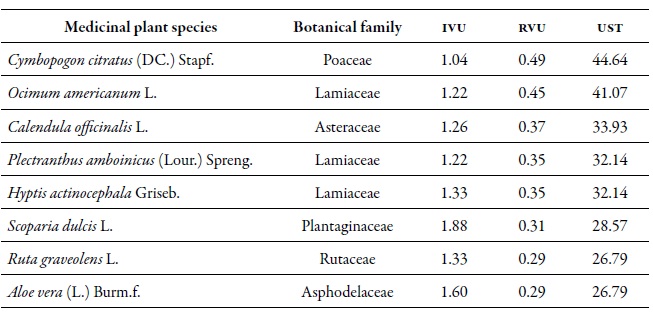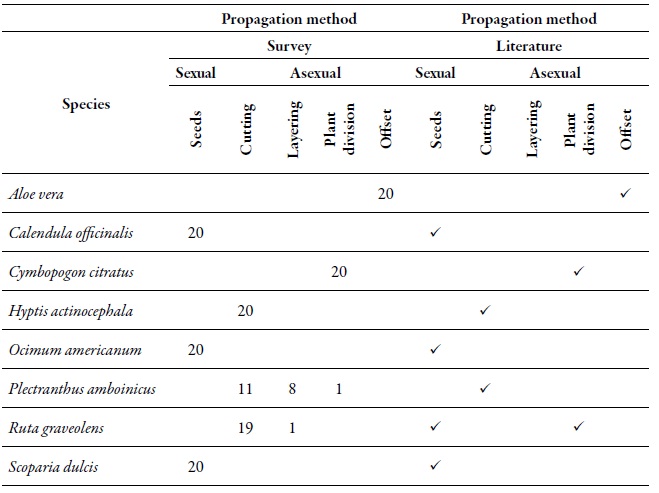Services on Demand
Journal
Article
Indicators
-
 Cited by SciELO
Cited by SciELO -
 Access statistics
Access statistics
Related links
-
 Cited by Google
Cited by Google -
 Similars in
SciELO
Similars in
SciELO -
 Similars in Google
Similars in Google
Share
Ciencia y Tecnología Agropecuaria
Print version ISSN 0122-8706On-line version ISSN 2500-5308
Cienc. Tecnol. Agropecuaria vol.20 no.3 Mosquera Sep./Dec. 2019 Epub Sep 10, 2019
https://doi.org/10.21930/rcta.vol20num3art:1597
Genética vegetal y biodiversidad
Ethnobotanical study and commercialization of medicinal plants in the Murocomba protected forest and its influence area in the Valencia Canton, Ecuador
1Docente investigador, Universidad Técnica Estatal de Quevedo, Facultad de Ciencias Ambientales, Escuela de Ingeniería Forestal. Quevedo, Ecuador.
2Docente investigador, Universidad Técnica Estatal de Quevedo, Facultad de Ciencias Ambientales, Escuela de Ingeniería en Ecoturismo. Quevedo, Ecuador.
3Docente investigador, Universidad Técnica Estatal de Quevedo, Facultad de Ciencias Ambientales, Escuela de Ingeniería en Ecoturismo. Quevedo, Ecuador.
4Tesista, Universidad Técnica Estatal de Quevedo, Facultad de Ciencias Ambientales, Escuela de Ingeniería en Ecoturismo. Quevedo, Ecuador.
5Tesista, Universidad Técnica Estatal de Quevedo. Facultad de Ciencias Ambientales, Escuela de Ingeniería en Ecoturismo. Quevedo, Ecuador
6Tesista, Universidad Técnica Estatal de Quevedo. Facultad de Ciencias Ambientales, Escuela de Ingeniería en Ecoturismo. Quevedo, Ecuador.
7Corporación Colombiana de Investigación Agropecuaria [AGROSAVIA]
The ethnobotanical uses of the medicinal plants in the Murocomba protected forest and its area of influence, located in the Valencia canton in Ecuador, were determined in this article; Fifty-six analytic types of surveys were applied in five locations. To obtain information on plant propagation, 20 surveys were carried out in forest localities. For the identification of the commercialization processes, 40 surveys were carried out with herbalist in the surrounding cantons. Fifty-one species, 44 genera, and 26 families were recorded. Cymbopogon citratus showed the highest absolute frequency. The locality with the highest number of species and individuals was Isla de la Libertad with a diversity of 3.42 according to the index of Shannon, and 0.9569 according to the index of Simpson. The Jaccard similarity index presented more interaction between El Dorado and Isla de la Libertad. The analysis of variance (Anova) showed significant differences in the frequency of species among the localities. C. citratus and Ocimum americanum, obtained higher values in the use value index (uvi), relative knowledge index (rki), and Significant Use Tramil index (sut). The propagation of eight species with the highest SUT was made through seeds, cuttings or plant divisions. The medicinal plants in herbalist shops with the highest demand were: Ruta graveolens, Matricaria chamomilla, and Peumus boldus. Finally, the medicinal plants with the highest SUT identified three types of added value: plants in pots, essential oils, and dehydrated plants, with commercialization costs ranging from 1.00 to 10.00 USD.
Keywords alternative medicine; botanical composition; indigenous knowledge; plant propagation; use-value index
En el presente artículo se determinó el uso etnobotánico de las plantas medicinales en el bosque protector Murocomba y su área de influencia, para lo cual se aplicaron 56 encuestas de tipo analítica en cinco localidades. Con el fin de obtener información sobre la propagación de plantas, se realizaron 20 encuestas en las localidades del bosque y, para la identificación de los procesos de comercialización, 40 encuestas a herbolarios en los cantones aledaños. Se registraron 51 especies, 44 géneros y 26 familias de plantas medicinales. Cymbopogon citratus presentó mayor frecuencia absoluta. La localidad con mayor número de especies e individuos fue Isla de la Libertad, así como con mayor diversidad con 3,42, según el índice de Shannon, y 0,9569, según el de Simpson. El índice de Jaccard presentó mayor interacción entre El Dorado e Isla de la Libertad. El Anova mostró diferencias significativas en frecuencia de especies entre las localidades. C. citratus y Ocimum americanum obtuvieron mayor Índice de Valor de Uso (ivu), Conocimiento Relativo de las Especies (rvu) y Uso Significativo Trámil (ust). La propagación de ocho especies con mayores UST se realiza mediante semilla, esquejes o división de planta. Las plantas medicinales en herbolarios con mayor demanda fueron Ruta graveolens, Matricaria chamomilla y Peumus boldus. Finalmente, en plantas medicinales con mayor ust se identificaron tres tipos de valor agregado: maceta, aceites esenciales y plantas deshidratadas, con costos de comercialización que oscilan entre $1,00 a $10,00 dólares.
Palabras clave composición botánica; conocimiento indígena; índice de valor de uso; medicina alternativa; propagación de plantas
Introduction
Ethnobotany studies the relationship between human groups with the plant environment, as well as the use that human beings give to this renewable resource. Medicinal plants are species that produce chemical compounds that have shown effectiveness in the treatment of conditions and that over the years, have been of great help to humans throughout the world (Pardo & Gómez, 2003).
Ethnobotanical studies on medicinal plants in Ecuador, mainly in the central Andean and in the Amazon regions, focus on the knowledge that the inhabitants of these areas possess on their benefits (Cerón, 2003). The importance of medicinal plants is based on the health care of human beings, especially for communities in developing countries who do not have access to modern medicine (Vera & Sánchez, 2015).
Ethnobotanical studies on medicinal plants carried out in the coastal region of Ecuador are scarce; besides, most of these have been developed in indigenous communities (Zambrano, Buenaño, Mancera, & Jiménez, 2015). Therefore, it is of great interest to conduct ethnobotanical research in coastal peasant communities, where people also have a constant relationship with their plant environment and with plants.
According to Rocha (2011), for this field of knowledge, there is a great interest in Ecuador, where a diversity of 500 species is estimated, of which 228 have been recorded more frequently; of these, 125 are destined for commercialization, and are marketed as fresh and dried product, and as powder extracts or as essential oils. The main destination of these, are buyers in the United States, Germany, France, Italy, and The Netherlands.
Accordingly, the aim of this work was to establish the ethnobotanical use and commercialization of the medicinal plants of the Murocomba Protective Forest in the Valencia canton, Ecuador, and its area of influence, to obtain timely information on the matter, with a focus on the conservation and sustainability of these resources.
Materials and methods
Location of the study site
The study was carried out in several towns formed by settlers distributed in Murocomba, including El Dorado, Isla de la Libertad, Río Negro, Gonzales Suárez and Mirador de Valencia, belonging to the Murocomba protective forest and its area of influence, in the canton of Valencia, province of Los Ríos, Ecuador, located at 00°57'09'' S and 79°20'54'' W (figure 1).
The limits of the study area are the following: to the north, the province of Cotopaxi where the Ilinizas reserve is located; to the south, the Valencia canton; to the east, the province of Cotopaxi; and to the west, Santo Domingo de los Tsáchilas. The area is part of the tropical humid forest ecological zone with irregular topography, finding high slopes with altitudes between 250 and 800 m.a.s.l.; the region has an average annual rainfall of 2,700 mm and an average annual temperature of 24 °C (Matamoros, 2015).
Fieldwork
The study was carried out between August 2017 and January 2018, through field visits. To define the number of surveys that should be carried out, the total population that lives in the six locations of the Murocomba protective forest and its area of influence was considered, with a total of 56 households (100 % of the population). A structured survey was designed, with closed questions, addressed to one of the persons in the household who knows and provides information on plant species for medicinal use. The most significant number of surveys was carried out in the locality of Isla de la Libertad with 26 households or sampling units, compared to the locality of Gonzales Suárez, where only one household was surveyed.
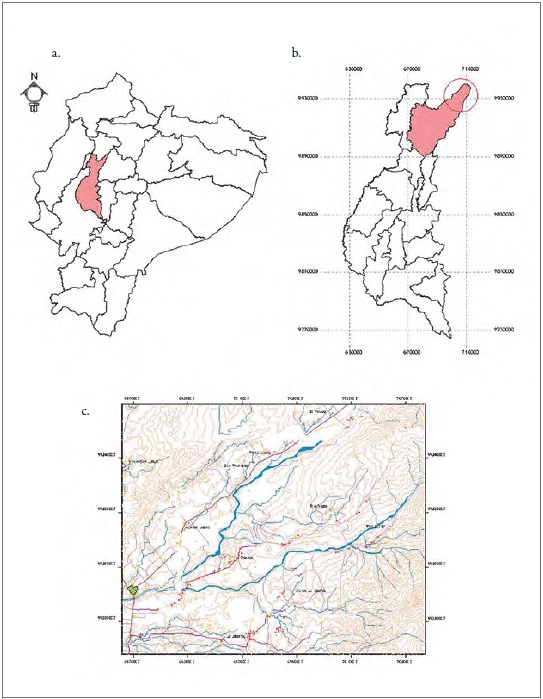
Source: Elaborated by the authors
Figure 1. Location of the Murocomba protective forest and its area of influence in the province of Los Ríos.a. Location of the province of Los Ríos in the Ecuadorian territory; b. Location of the Valencia canton in theprovince of Los Ríos; c. Location of the study area.
The purpose of the surveys was to obtain information on the socio-cultural aspects of the interviewees, such as his/her name, age, gender, and name of the locality to which he/she belongs. Additionally, also data referring to medicinal plants, such as the disease that it heals, employment form, preparation, way of administration and part(s) of the plant used in the treatment of diseases.
A total of 56 informants were interviewed, including 28 women and 28 men, whose age range was between 20 and 100 years; hence, informants were classified into four intervals as follows. Interval I, between 20 and 40 years; interval II, between 41 and 60 years; interval III, between 61 and 80 years; IV interval, between 81 and 100 years.
Collection and identification of botanical samples
Botanical specimens of the different plant species with medicinal use cited by the inhabitants of the study area were collected for identification and subsequent registration. The classification system of the Angiosperm Phylogeny Group (APG III, 2009) was used for the taxonomic identification of medicinal plants, and these are kept in the herbarium registry of the Faculty of Environmental Sciences of Universidad Técnica Estatal de Quevedo, in Ecuador.
The classification of diseases was performed using the keys proposed by Bhattarai, Chaudhary, Quave and Taylor (2010) and Angulo, Rosero and González (2012), which consists of 12 categories according to the human body system.
Statistical analysis of ethnobotanical data
The data obtained were processed with the use of the Microsoft Excel 2010 software and the IBM SPSS program, through descriptive statistics and frequency analysis. The software PAST 2.02 (Hammer, Harper, & Ryan, 2001) was employed to calculate the Simpson and Shannon diversity index and the Jaccard similarity index. For the calculation of the interaction between the six locations in the forest, the cluster analysis method was used, which allows grouping the six locations with higher species similarity. To establish significant differences between the locations of the Murocomba protective forest and its area of influence, the analysis of variance (Anova) was used based on the number of individuals per species in the six locations studied, using the PAST 2.02 software (Hammer et al., 2001).
The t statistic was used to assess significant differences in the six locations of the Murocomba protective forest, depending on the parameters species, individuals, dominance, Shannon, Simpson, and similarity. The use value index ( uvi ), the relative knowledge index (rki), and the Significant Use Tramil ( sut ) were calculated to establish the cultural importance of the species.
Use Value Index (UVI)
The uvi established the most important species or with cultural value for all informants interviewed in each sampling unit. Equation 1, according to Phillips (1996), was used to calculate the general UVI of each species for all informants (UVIs).
Where UVis is the use-value of the species per informant, and Ns is the number of informants per species.
Relative knowledge index (RKI)
To calculate the RKI, equation 2, proposed by Phillips (1996), was used.
Where VUis is the use-value of the species per informant; UVIs is the use-value index of the species, and Nsp is the number of informants per species.
Significant use Tramil (SUT)
The level of significant use for each species and its cultural acceptance was established using the methodology proposed by Germosén (1995), which states that the medicinal uses by each informant, cited with a frequency higher than or equal to 20 %, can be considered significant due to their cultural acceptance, and deserves to be evaluated and validated scientifically. The SUT was calculated using equation 3 (Germosén, 1995).
Where Use species is the number of citations for each species, and Nis is the number of informants surveyed.
Identification of plant species for medicinal use in the Murocomba protective forest and its area of influence
The species used for the establishment and identification of propagation methods were selected by using the list of species with the highest uvi and rki. Subsequently, a second survey was prepared to identify the methods and the propagation methods used for the medicinal plants used in the study area. This survey was applied to 20 inhabitants of the Murocomba protective forest area and its area of influence, where the following variables were considered. Importance of propagation and conservation, method used (sexual or asexual), reproduction by seed, vegetative reproduction (cuttings, plant division, layering, and offsets), reproduction time, propagation area (pot, container, cover or directly in the soil), pregerminative treatments and reason to propagate medicinal plants.
Identification of the commercialization processes of medicinal plants with higher demand by herbalists located next to the study site
The rapid rural diagnostic methodology was implemented through surveys applied to 40 herbalists identified in the cantons of Quevedo, Valencia, La Maná and El Empalme, to identify the commercialization processes and establish the supply and demand of the species.
Results and discussion
A total of 51 medicinal plants species distributed in 44 genera and 26 botanical families were found. These results are similar to another ethnobotanical study conducted in the San Carlos parish, Quevedo canton by Zambrano et al. (2015), and in the San Jacinto community, Ventanas canton by Paredes, Buenaño and Mancera (2015), with 29 and 21 families, respectively. The families with the highest number of medicinal plant species in the study area were Lamiaceae (8 species), Asteraceae (6 species), Euphorbiaceae and Rutaceae (3 species each) (figure 2), which coincides with a study conducted in rural areas of the Bogotá Plateau in Colombia by Pérez and Matiz (2017), where the Lamiaceae family showed a higher number of species (14 species - 6 %). In Ecuador, Asteraceae, Fabaceae, and Rubiaceae are the families with the highest number of species with medicinal uses (Balslev, Navarrete, Torre, & Macías, 2008), a result similar to the one found in a study carried out by Bernal, García and Quevedo (2011) in Colombia.
The species most frequently found in the study site, in descending order, were Cymbopogon citratus (DC.) Stapf. (Poaceae) with 25 citations; Ocimum americanum L. (Lamiaceae) with 23; Calendula officinalis L. (Asteraceae) with 19; Plectranthus amboinicus (Lour.) Spreng. (Lamiaceae) with 18; Hyptis actinocephala Griseb. (Lamiaceae) with 18; Ruta graveolens L. (Rutaceae) with 15; Aloe vera (L.) Burm.f. (Asphodelaceae) with 15; Melissa officinalis L. (Lamiaceae) with 13, and Scoparia dulcis L. (Plantaginaceae) with 14. On the other hand, the following species were recorded with a minimum frequency: Bryophyllum adelae (Hamet) A.Berger (Crassulaceae), Artocarpus altilis (Parkinson ex F.A.Zorn) Fosberg, (Moraceae), Cestrum nocturnum L. (Solanaceae), Columnea orientandina (Wiehler) L.P.Kvist & L.E.Skog (Gesneriaceae), Croton lechleri Müll.Arg. (Euphorbiaceae), Euphorbia cotinifolia L. (Euphorbiaceae), Iresine lindenii Van Houtte (Amaranthaceae), Jatropha curcas L. (Euphorbiaceae), Petiveria alliacea L. (Petiveriaceae), Phyllanthus acidus (L.) Skeels (Phyllanthaceae), Portulaca oleracea L. (Portulacaceae), Portulaca sp. (Portulacaceae), Psychotria viridis Ruiz & Pav. (Rubiaceae), and Tanacetum parthenium (L.) Sch.Bip. (Asteraceae). The species with the highest absolute frequency in the current research was C. citratus. Similar results were obtained in the research conducted by Zambrano et al. (2015), in which the same species showed the highest frequency in the sites sampled.
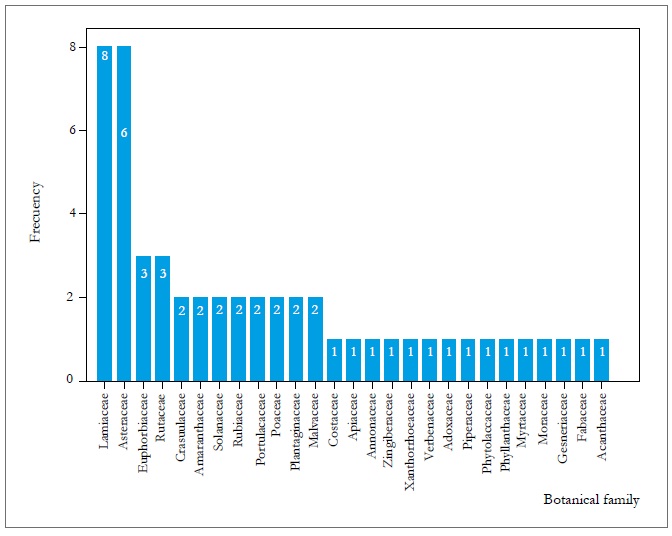
Source: Elaborated by the authors
Figure 2. Frequency of species per botanical family found in the Murocomba protective forest and its area ofinfluence, Ecuador, in 2018.
The location Isla de la Libertad showed a higher number of species with medicinal use (44 species), as well as the highest number of individuals, with 149 records. The most dominant locality within the study area was Gonzales Suárez with 0.5 (table 1).
The Shannon index for the Murocomba protective forest and its area of influence showed medium diversity; the locality Isla de la Libertad showed the highest diversity with 3.42. These results are different from those obtained by Vásquez (2014) in a study carried out in the urban gardens of canton Loja, in which the Shannon index indicates a high diversity in the parish of El Valle (3.9). Regarding the Simpson index, the site with the highest diversity was Isla de la Libertad with 0.9569, in contrast to the study carried out by Vásquez (2014), who concluded that the four parishes studied have high diversity with values higher than 0.9. Regarding the similarity index, the site with a value equal to 1 is Gonzales Suárez.
The Jaccard index calculated for the six locations of the study area shows the interaction of El Dorado and Murocomba with 0.57143 × 100 % as the one with the highest similarity of species (table 2).
Table 1. Species, individuals, dominance and diversity indices of the medicinal plants found in the Murocomba protective forest and its area of influence, Valencia canton, Ecuador
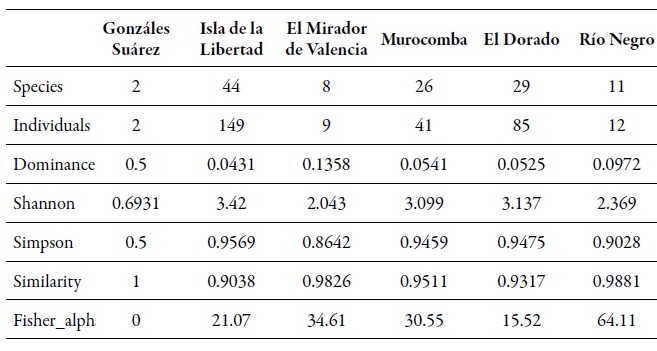
Source: Elaborated by the authors
Table 2. Jaccard index interactions matrix between localities in the area of influence of the Murocomba protective forest
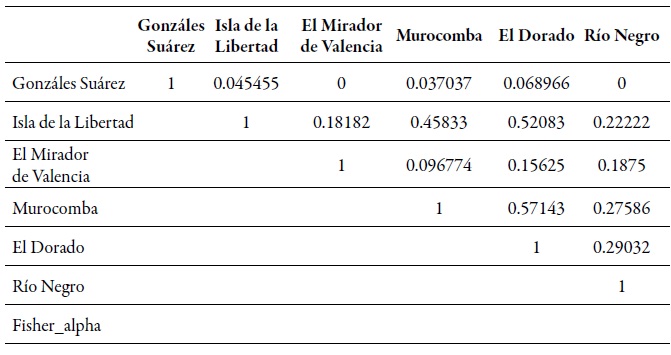
Source: Elaborated by the authors
The results of the cluster analysis used in the Dorado, Río Negro, and El Mirador de Valencia; localities of the study area show two clusters the second group is formed solely by Gonzales above 12.90 %. The first group is formed by Suárez as it is distant from the first group the localities Isla de la Libertad, Murocomba, El (figure 3).
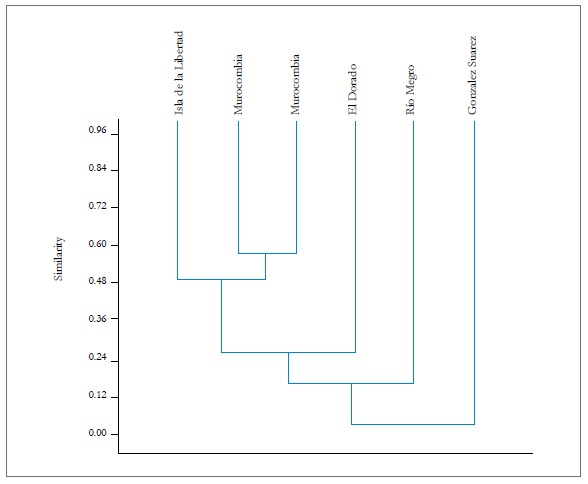
Source: Elaborated by the authors
Figure 3. Similarity dendrogram of the sampling units of the Murocomba protective forest, Valencia canton, Ecuador.
The Anova exposes significant differences in the forest, being p = 1.126E-19 < 0.05 at 95 % of studied locations of the Murocomba protective probability (table 3).
Table 3. Analysis of variance for the establishment of frequency in the localities of the Murocomba protective forest, Valencia canton, Ecuador

Source: Elaborated by the authors
The Tukey’s means separation test (table 4) shows significant differences between the locations of El Dorado and Gonzales Suárez (p = 3,23E-05).
The Student’s t-test for separation of means (table 5) in the six locations of the Murocomba protective forest and considering the indexes evaluated, exposes significant differences p < 0.05 for species(p = 0.0268), for individuals (p = 0.0882), for the Shannon index (p = 0.0021), for the Simpson index (p = 0.0001), and for the similarity index(p = 0.0000).
Table 4. Tukey’s means separation test for peer comparisons between localities of the Murocomba protective forestand its area of influence, Valencia canton, Ecuador
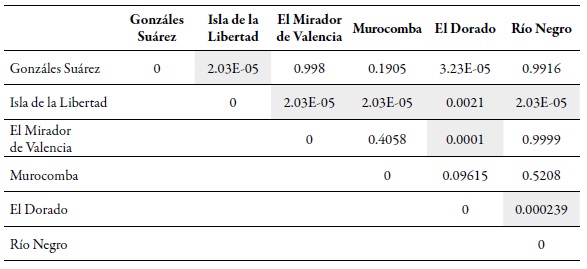
Source: Elaborated by the authors
Table 5. Student's t-test for separation of means at p < 0.05 probability for the six locations of the Murocombaprotective forest
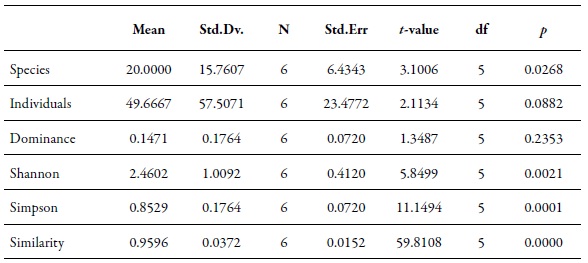
Source: Elaborated by the authors
The subcategories of medicinal use most frequently found are digestive system diseases and infectious and parasitic diseases (32.5 %). In general, infections (18.9 %) are the most treated illnesses in the research conducted by Gallegos (2017), unlike the current research in which medicinal plants are used to treat most diseases that affect the entire body and others (32.9 %) as well as gastrointestinal problems (31.9 %) (figure 4).
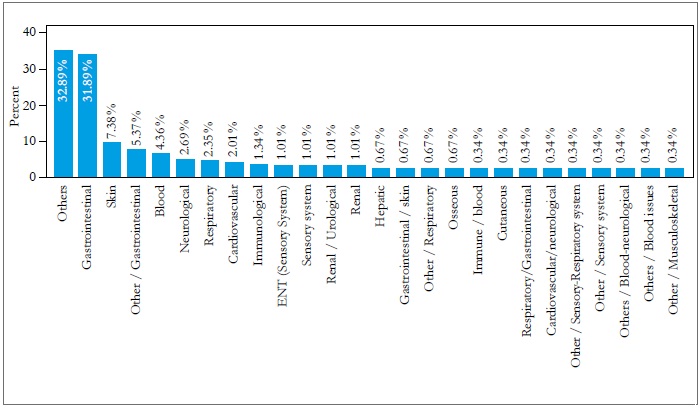
Source: Elaborated by the authors
Figure 4. Subcategories of medicinal use best represented in the traditional medicine of the communities located inthe Murocomba protective forest and its area of influence.
In the research carried out by Fernández, Minaya and Palomino (2015), 46 % of the persons prefer to boil the medicinal plants they will use, 34 % consume them raw, 15 % leave them to rest for a while, and only 5 % use them in infusion; similar results were obtained in the current research where most of the treatments were prepared by cooking (66.78 %) and by grounding (27.9) (figure 5).

Source: Elaborated by the authors
Figure 5. Method used to prepare treatments with medicinal plants in the study area.
The most commonly used administration route for the consumption of medicinal plants was by drinking (61.7 %) as well as by external use (33.9) as can be seen in Figure 6. These results are similar to those presented by Domínguez, Cruz and González (2015), where 67.5 % of the plants are prepared as drinks and ingested in this way.
The leaves are the part of the plant that is mostly used in the preparation of medicinal treatments and represent 84.9 % of the total structures used for this purpose (figure 7). Similar results were obtained in the research by Domínguez et al. (2015), which indicates that the leaf is used more frequently in the preparation of medicinal treatments (54.1 %), followed by the root (10.2 %); this contrasts with the research carried out by Fernández, Minaya and Palomino (2015), in which 61 % of the respondents prefer to use the fruits and only 23 % use the leaves.

Source: Elaborated by the authors
Figure 6. Administration route of medicinal treatments in the study area.
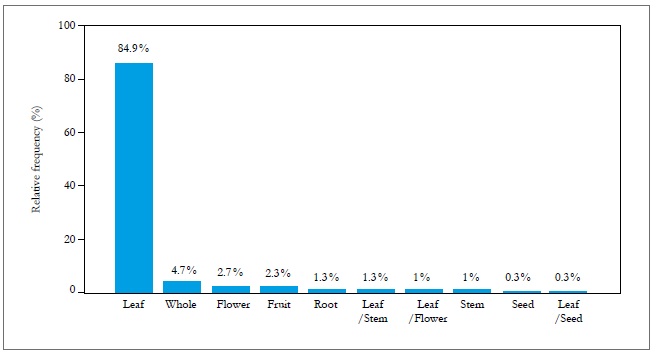
Source: Elaborated by the authors
Figure 7. Part of the plant used in the preparation of medicinal treatments in the area of influence of the Murocombaprotective forest.
Analysis of the medicinal plant propagation knowledge in the Murocomba protective forest and its area of influence
The population surveyed in the Murocomba protective forest and its area of influence considers essential to propagate and conserve the medicinal plants used. The most widely used propagation method is asexual, using cuttings; seed storage and conservation are not carried out, and the average reproduction time for medicinal plant species is 16 to 22 days.
Moreover, pots are used as propagation containers; they do not use fertilizers or chemicals to stimulate growth, nor to control pests and diseases, and propagation is carried out solely to obtain plants to be used for medicinal purposes.
Species with the highest SUT reported in the Murocomba protective forest and its area of influence
Table 6 shows the plant species for medicinal usewith a SUT value higher than 20 %; among thesewe find C. citratus (44,64), O. americanum (41,07),C. officinalis (33,93), P. amboinicus (32,14), H.actinocephala (32,14), S. dulcis (28,57), R. graveolens(26,79) and A. vera (26,79).
Analysis of the propagation knowledge of medicinal plants with higher SUT in the Murocomba protective forest and its area of influence
Eight medicinal plants with the highest sut were identified. Of these species used for medicinal purposes, respondents propagated them employing two or three methods. A comparison was made between the propagation methods used by the inhabitants registered in the cited literature (table 7), and the ones reported in the study area with the highest sut. Seeds, cuttings, and plant division are the most frequently used propagation methods by the population surveyed in the Murocomba protective forest and its area of influence. These results are similar to those found by Paván, Furlan, Caminos and Ojeda (2016) in San Pedro, northern Argentina, where the authors carried out 30 interviews to the residents on the recognition, use and production of medicinal plants, who said they propagate these from seeds and cuttings.
Marketing of medicinal plants with higher demand by herbalists in cantons adjacent to the study area
The Quevedo canton showed the most significant number of herbalists, with a total of 21 establishments. The majority of the herbalists surveyed are women with an age range from 40 to 60 years. The herbalists most frequently found were located in the market, and the time they have been carrying out this activity exceeds five years. Furthermore, they acquire processed medicinal plants from another province. Of the 17 species identified with the highest demand, the main ones were Ruta graveolens, Matricaria chamomilla (Asteraceae) and Peumus boldus (Monimiaceae). The botanical families with the most substantial amount of medicinal plants sold by herbalist were Lamiaceae, Asteraceae, and Fabaceae. The budget for the acquisition of plant species of medicinal interest exceeds 151.00 USD per month, and consumers acquire them throughout the year in a dry state. Similar results were obtained by Paván et al. (2016) in San Pedro, northern Argentina, identifying 68 botanical species, corresponding to the Lamiaceae family with 38.8 %, followed by Asteraceae with 15.98 %. On the other hand, Huamantupa et al. (2011) identified 152 medicinal plants in a research conducted in Cusco, Peru, with a total of 45 families, of which Asteraceae and Lamiaceae obtained the highest number of species with 36 and 12, respectively. The added value of the medicinal plants reported with a higher SUT was defined using potted plants, with values ranging between 1.00 and 2.00 USD; essential oil extracts costs from 4.00 to 10.00 USD and dehydrated plants in bags cost 1.00 USD. These plants are generally used for body treatments, aromatherapy, and certain diseases.
Conclusions
In the six locations of the Murocomba protective forest and its area of influence, 51 medicinal plant species were obtained and grouped into 44 genera and 26 botanical families. The Asteraceae, Lamiaceae and Plantaginaceae families and the species Cymbopogon citratus, Ocimum americanum and Calendula officinalis showed the highest frequency.
The Shannon and Simpson indices express a varied diversity of medicinal plants in the study area localities, being low, medium and high according to the locality; hence, Isla de la Libertad was the one that showed the highest diversity. The localities El Dorado and Isla de la Libertad showed the highest similarity of medicinal plants. The locations analyzed in the current research showed significant differences in frequencies of medicinal plant species according to the Anova at 95 % probability. The Student’s t-test exposes significant differences for species, individuals, and the indices of Shannon, Simpson, and similarity (Jaccard) between the six sampling locations.
For the elaboration of the medicinal treatments, the leaves are mostly used, and the preparation method preferred is by cooking or infusion. Therefore, the route of administration of the medicine is oral or by drinking, and these are used to treat diseases that affect the entire body, known scientifically as culturebound syndromes (i.e., evil eye, bad air, among others), followed by those that affect the gastrointestinal system.
According to the use value index, the relative knowledge of the species by several informants and the level of significant use Tramil, the species with the highest cultural value are Cymbopogon citratus, Ocimum americanum and Calendula officinalis.
Surveys show that the inhabitants of the Murocomba protective forest and its area of influence mainly use the asexual propagation method using cuttings to propagate existing medicinal plants in the study area; meanwhile, the reproduction and multiplication of the species reported with the highest SUT is carried out using seeds, cuttings or through plant division. Of the eight species reported with the highest sut, the only one that correlates in the study area is Ruta graveolens, which means that the other species identified can be incorporated into the market.
Acknowledgment
The authors wish to thank Fondo Competitivo de Investigación Científica y Tecnológica (Focicyt) for funding this research. The authors also want to thank Universidad Técnica Estatal de Quevedo, to the Faculty of Environmental Sciences, and to Mr. Manuel Arcos, for his collaboration during the fieldwork.
REFERENCES
Angulo, A., Rosero, R., & González, M. (2012). Estudio etnobotánico de las plantas medicinales utilizadas por los habitantes del corregimiento de Genoy, Municipio de Pasto, Colombia. Revista Universidad y Salud, 14(2), 168 - 185. Recuperado de https://www.revistas.udenar.edu.co/index.php/usalud/article/view/1277 [ Links ]
Angiosperm Phylogeny Group (APG) III. (2009). An update of the Angiosperm Phylogeny Group classification for the orders and families of flowering plants: APG III. Journal of the Linnean Society, 161(2), 105-121. doi:10.1111/ j.1095-8339.2009.00996.x. [ Links ]
Balslev, H., Navarrete, H., Torre, L. D., & Macías, M. (2008). Enciclopedia de las plantas útiles del Ecuador. Quito, Ecuador: Herbario QCA & Herbario AAU. [ Links ]
Bernal, H., García, H., & Quevedo, G. (2011). Pautas para el conocimiento, conservación y uso sostenible de las plantas medicinales nativas en Colombia: Estrategia Nacional para la Conservación de Plantas. Bogotá, Colombia: Instituto de Investigación de Recursos Biológicos Alexander von Humbolt. [ Links ]
Bhattarai, S., Chaudhary, R., Quave, C., & Taylor, R. (2010). The use of medicinal plants in the trans-himalayan arid zone of Mustang district, Nepal. Journal of Ethnobiology and Ethnomedicine, 6(14), 1-11. doi:10.1186/1746-4269-6-14. [ Links ]
Cerón, C. E. (2003). Manual de Botánica, Sistemática, Etnobotánica y Métodos de Estudio en el Ecuador. Quito, Ecuador: Universidad Central del Ecuador. [ Links ]
Domínguez, C., Cruz, G., & González, C. (2015). Plantas de uso medicinal de la Reserva Ecológica “Sierra de Otontepec”, municipio de Chontla, Veracruz, México. CienciasUAT, 9(2), 41-52. Recuperado de https://www.scielo.org.mx/pdf/cuat/v9n2/2007-7858-cuat-9-02-00041.pdf [ Links ]
Fernández, N., Minaya, N., & Palomino, N. (2015). Evaluación sobre el uso de plantas medicinales en el tratamiento de hipertension arterial HNERM ESSALUD-junio 2015. Revista Cientifica Alas Peruanas, 2(1), 1-27. doi:10.21503/sd. v2il.899. [ Links ]
Gallegos, M. (2017). Las plantas medicinales: usos y efectos en el estado de salud de la población rural de Babahoyo – Ecuador (tesis doctoral). Universidad Nacional Mayor de San Marcos, Lima, Perú. Recuperado de https://www.cybertesis.unmsm.edu.pe/handle/cybertesis/6415 [ Links ]
Germosén, L. (1995). Hacia una farmacopea vegetal caribeña. Santo Domingo, República Dominicana: Tramil. [ Links ]
Hammer, O., Harper, D., & Ryan, P. (2001). Past: Paleontological, Statistic sofware package for education and data analysis. Palaeontologia Electronica, 4(1), art. 4. https://www.palaeo-electronica.org/2001_1/past/issue1_01.htm [ Links ]
Huamantupa, I., Cuba, M., Urrunaga, R., Paz, E., Ananya, N., ... Coasaca, H. (2011). Riqueza, uso y origen de plantas medicinales expendidas en los mercados de la ciudad del Cusco. Revista Peruana de Biología, 18(3), 283-292. doi:10.15381/rpb.v18i3.439. [ Links ]
Matamoros, G. (2015). Diseño de dos Senderos, para la Ruta de Aviturismo en el Bosque Protector “Murocomba”, Cantón Valencia, Provincia de Los Ríos (trabajo de grado). Universidad Técnica Estatal de Quevedo, Quevedo, Ecuador. [ Links ]
Pardo, M., & Gómez, E. (2003). Etnobotánica: Aprovechamiento tradicional de plantas y patrimonio cultural. Anales del Jardín Botánico de Madrid, 60(1), 171-182. [ Links ]
Paredes, D., Buenaño, M., & Mancera, N. (2015). Usos de plantas medicinales en la comunidad San Jacinto del cantón Ventanas, Los Ríos-Ecuador. Revista de la Universidad de Ciencias Aplicadas y Ambientales Actualidad & Divulgaciòn Científica, 18(1), 39-50. doi:10.31910/rudca.v18.n1. 2015. 452. [ Links ]
Paván, M., Furlan, V., Caminos, S., & Ojeda, M. (2016). Las personas y las plantas medicinales en el noroeste de Córdoba, Argentina. Reconocimiento y valoración de los recursos naturales locales. Boletín Latinoamericano y del Caribe de Plantas Medicinales y Aromáticas, 16(1), 78-87. Recuperado de https://www.hdl.handle.net/11336/44985 [ Links ]
Pérez, D., & Matiz, L. (2017). Uso de las plantas por comunidades campesinas en la ruralidad de Bogotá D. C., Colombia. Caldasia, 39(1), 68-78. doi:10.15446/caldasia. v39n1.59932 [ Links ]
Phillips, O. (1996). Some Quantitative Methods for Analysing Ethnobotanical Knowledge. En M. N. Alexiades (Ed.), Selected Guidelines For Ethnobotanical Research. A Field Manual (pp. 172-197). Nueva York, EE. UU.: The New York Botanical Garden. [ Links ]
Rocha, S. (2011). Estudio de factibilidad para la creación de una microempresa para la industralización de plantas medicinales y su comercialización en Ibarra (trabajo de grado. Universidad Técnica del Norte, Ibarra, Ecuador. Recuperado de https://www.repositorio.utn.edu.ec/bitstream/123456789/1500/1/02%20ICA%20152%20TESIS.pdf [ Links ]
Vásquez, P. (2014). Importancia cultural de la flora mantenida en los jardines de las viviendas de las Parroquias Urbanas del Cantón Loja (trabajo de grado). Universidad Técnica Particular de Loja, Loja, Ecuador. [ Links ]
Vera, B., & Sánchez, M. (2015). Registro de algunas plantas medicinales cultivadas en San Cristóbal, municipio de Medellín (Antioquia - Colombia). Revista Facultad Nacional de Agronomía, Medellín, 68(2), 7647-7658. [ Links ]
Zambrano, L., Buenaño, M., Mancera, N., & Jiménez, E. (2015). Estudio etnobotánico de plantas medicinales utilizadas por los habitantes del área rural de la Parroquia San Carlos, Quevedo, Ecuador. Revista Universidad y Salud, 17(1), 97-111. [ Links ]
Received: June 13, 2018; Accepted: June 11, 2019











 text in
text in 





